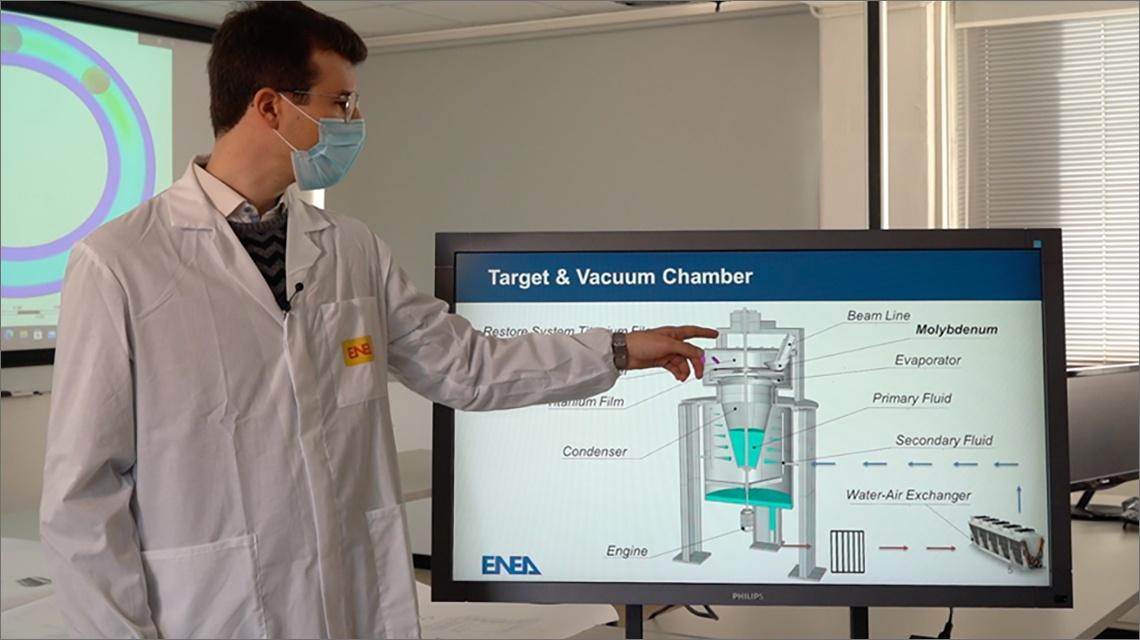Italian National Agency for New Technologies, Energy and Sustainable Economic Development

Health: Radiopharmaceuticals, in Nature an innovative ENEA approach to develop national production
A supply chain with compact, medium-sized plants across the country
Developing a national supply chain of plants to produce radiopharmaceuticals for cancer diagnosis. This is the innovative approach described by ENEA researchers in the international journal Nature[1] on the safe, sustainable production of Molybdenum (99Mo), the radioisotope precursor of technetium-99 (99mTc), the most widely used element in the world in nuclear medicine for SPECT-type diagnostics.[2] Around 30 million are performed each year, with a global market worth around $8 billion.
“The goal is to build medium-sized, compact, modular and decentralised plants throughout the country capable of ensuring sustainable, safe processes for the production of Molybdenum (99Mo), also in light of the COVID-19 pandemic that has created new and unexpected issues in the supply chain”, explained Antonino Pietropaolo and Marco Capogni, the ENEA researchers who wrote the study in Nature together with Lina Quintieri of the Science and Technology Facilities Council (UK). “Creating robust and resilient local supply chains to produce this radioisotope is also an urgent need to address the current shortage after the closure of the Canadian NRU[3] fission reactor, one of the world's largest producers, and the ageing of other reactors used for production”.
In Italy, a project of this type was launched at the ENEA Brasimone Centre. It is called SORGENTINA-RF[4], and aims to provide medium- to long-term alternatives to both fission reactors and the use of Uranium-235 for reasons of nuclear non-proliferation. Production processes of 99Mo that are valid alternatives to fission and the use of uranium have long been the subject of study by the international scientific community and the radiopharmaceutical industry. ENEA has been studying this issue since 2015 with exploratory experiments on the use of fusion neutrons[5], and the SORGENTINA-RF project represents the culmination of these experiments.
SORGENTINA-RF was created as part of the expansion of the ENEA research centre in Brasimone (BO), to which, among others, the metropolitan city of Bologna, under the NRRP (National Recovery and Resilience Plan), recently allocated €7 million for improving accessibility and upgrading a number of buildings, which further supplements the €3.5 million investment of the Emilia-Romagna Region and the €1.5 million from ENEA, directly allocated to the development of a thermomechanical prototype of the SORGENTINA-RF plant. The project is being developed by a team of 50 ENEA researchers and technicians with expertise in fusion, solid-state and accelerator physics, radiochemistry, nuclear engineering and materials science. Moreover, ENEA also made available the infrastructure and laboratories of four research centres. In addition to Brasimone, the following are also involved: the ENEA Research Centre in Bologna, the Frascati Research Centre with the Frascati Neutron Generator,[6] the most intense 14 MeV neutron source in Europe and one of the most intense in the world, which has made it possible to demonstrate the feasibility of producing 99Mo with fusion neutrons; the Casaccia Research Centre, with the National Institute of Ionising Radiation Metrology (INMRI) for the aspect of accurate activity measurements,[7] and the Radiological Characterisation and Nuclear Waste Management Laboratory for the various radiochemical aspects of the processes studied.[8]
Thanks to a scientific collaboration between these laboratories and the University of Ferrara, between 2016 and 2017 an experiment was performed that allowed studying the entire production chain of the SPECT diagnostic radiopharmaceutical starting from the irradiation of natural molybdenum, obtaining a high degree of purity and making it possible to calculate estimates that paved the way for the SORGENTINA-RF project.[7]
Another strategic aspect of the project is the new prospects for the production of other medical radioisotopes such as 64Cu (a theranostic radionuclide, i.e. both therapeutic and diagnostic) and the development of R&D in various fields of materials science and technology.
For more information
Antonino Pietropaolo, ENEA - Nuclear Technology Laboratory,
Marco Capogni, ENEA - Radioactivity Section, National Institute of Ionising Radiation Metrology (INMRI),
Note
[1] A. Pietropaolo, M. Capogni, L. Quintieri, Nature 603, 393 (2022)
[2] Single Photon Emission Computed Tomography (Tomografia a emissione di fotone singolo)
[3] Crisi mondiale del 2009 - cfr Gould, P. Europe's isotope shortage will continue into 2009. Nature (2008).
[4] A. Pietropaolo, et al., Eur. Phys. J. Plus 136, 1140 (2021).
[5] M. Capogni, A. Pietropaolo, L. Quintieri, Rapporto tecnico interno ENEA - RT/2016/32/ENEA
[6] A. Pietropaolo et al., J. Phys.: Conf. Ser. 746, 012037 (2016).
[7] M. Capogni et al, Appl. Radiat. Isotop. 134, 105 (2018).
